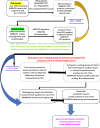Setting research priorities for sexual, reproductive, maternal, newborn, child and adolescent health in humanitarian settings
- PMID: 33771212
- PMCID: PMC7995567
- DOI: 10.1186/s13031-021-00353-w
Setting research priorities for sexual, reproductive, maternal, newborn, child and adolescent health in humanitarian settings
Abstract
Background: An estimated 70.8 million people are forcibly displaced worldwide, 75% of whom are women and children. Prioritizing a global research agenda to inform guidance, service delivery, access to and quality of services is essential to improve the survival and health of women, children and adolescents in humanitarian settings.
Method: A mixed-methods design was adapted from the Child Health and Nutrition Research Initiative (CHNRI) methodology to solicit priority research questions across the sexual, reproductive, maternal, newborn, child and adolescent health (SRMNCAH) domains in humanitarian settings. The first step (CHNRI) involved data collection and scoring of perceived priority questions, using a web-based survey over two rounds (first, to generate the questions and secondly, to score them). Over 1000 stakeholders from across the globe were approached; 177 took part in the first survey and 69 took part in the second. These research questions were prioritized by generating a research prioritization score (RPP) across four dimensions: answerability, program feasibility, public health relevance and equity. A Delphi process of 29 experts followed, where the 50 scored and prioritized CHRNI research questions were shortlisted. The top five questions from the CHNRI scored list for each SRMNCAH domain were voted on, rendering a final list per domain.
Results: A total of 280 questions were generated. Generated questions covered sexual and reproductive health (SRH) (n = 90, 32.1%), maternal health (n = 75, 26.8%), newborn health (n = 42, 15.0%), child health (n = 43, 15.4%), and non-SRH aspects of adolescent health (n = 31, 11.1%). A shortlist of the top ten prioritized questions for each domain were generated on the basis of the computed RPPs. During the Delphi process, the prioritized questions, based on the CHNRI process, were further refined. Five questions from the shortlist of each of the SRMNCAH domain were formulated, resulting in 25 priority questions across SRMNCAH. For example, one of the prioritized SRH shortlisted and prioritized research question included: "What are effective strategies to implement good quality comprehensive contraceptive services (long-acting, short-acting and EC) for women and girls in humanitarian settings?"
Conclusion: Data needs, effective intervention strategies and approaches, as well as greater efficiency and quality during delivery of care in humanitarian settings were prioritized. The findings from this research provide guidance for researchers, program implementers, as well as donor agencies on SRMNCAH research priorities in humanitarian settings. A global research agenda could save the lives of those who are at greatest risk and vulnerability as well as increase opportunities for translation and innovation for SRMNCAH in humanitarian settings.
Keywords: Adolescent health; CHNRI; Child health; Delphi; Humanitarian conflict; Humanitarian pediatrics; Maternal health; Newborn health; Reproductive health; Research priorities; Sexual health.
Conflict of interest statement
The authors declare that they have no competing interests. The authors alone are responsible for the views expressed in this [article] and they do not necessarily represent the views, decisions or policies of the institutions with which they are affiliated.
Figures
References
-
- UNHCR, 2019: Figures at a glance. Accessed at: https://www.unhcr.org/figures-at-a-glance.html. Accessed 17 June 2020.
-
- Inter-agency Working Group on Reproductive Health in Crises . Inter-agency Field Manual on Reproductive Health in Humanitarian Settings: 2010 Revision for Field Review: Inter-agency Working Group on Reproductive Health in Crises. 2010. - PubMed
-
- Peek L. Children, Youth and Environments. Vol. 18, No. 1, Children and Disasters (2008), pp. 1–29. http://www.jstor.org/stable/10.7721/chilyoutenvi.18.1.0001. [Last Accessed 30.12.2018]. - DOI
Grants and funding
LinkOut - more resources
Full Text Sources
Other Literature Sources


